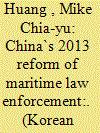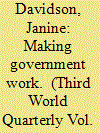| Srl | Item |
| 1 |
ID:
148534


|
|
|
|
|
| Summary/Abstract |
Since late 2012, Chinese President Xi Jinping has introduced far-ranging measures to “build China into a maritime power (建設海洋强國).” One notable campaign was the creation of a centralized China Coast Guard (CCG) force and the National Oceanic Commission (NOC), as the previous lack of a functional mechanism to coordinate China`s maritime policies and five maritime law enforcement agencies, the “five dragons,” has been a longstanding problem hindering the country from effectively administering its maritime territories. This paper argues that the operational functions of the CCG have been developed, although not fully, and CCG vessels are now undertaking patrol missions in an orderly pattern. Nevertheless, at the policymaking level, the progress of the reform is rather limited. Particularly, the development of the NOC, an organ responsible for the “top-level design” of China`s grand maritime strategy, as well as the legal foundations for the CCG`s operations are still incomplete. Moreover, Beijing`s decision not to incorporate the Maritime Safety Administration into the CCG suggests that the country is adopting an old logic of “crossing the river by feeling the stones (摸着石頭過河)” while still pledging to reach its maritime power goal, part of the Chinese dream for national rejuvenation.
|
|
|
|
|
|
|
|
|
|
|
|
|
|
|
|
| 2 |
ID:
089717


|
|
|
|
|
| Publication |
2009.
|
| Summary/Abstract |
Numerous studies outlining what needs to be done to improve the U.S. interagency system have been conducted in the past few decades. Together, these studies reflect a growing consensus on the range of changes needed across the government, from personnel reform, to changes in processes and structures. This article does not quibble with this consensus. Rather, in light of the current economic crisis and the challenges we face in Iraq and Afghanistan, this piece argues that dramatic reform may be a luxury we cannot afford right now. Instead of offering another proposal for large-scale reorganization, the author suggests a way to get started now; one that focuses on winning the fights we are currently in while setting the trajectory for long-term change.
|
|
|
|
|
|
|
|
|
|
|
|
|
|
|
|